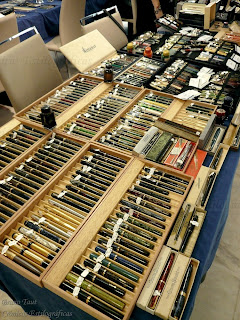
The maki-e Pelikan on display at a stationery shop in Kawasaki, Japan. The picture was taken on November 10th (2012).
It is very hard to understand these variations. It really looks like some –if not all— pen brands had not understood the idea of globalization or, even worse, they wanted a globalized world in just one direction—for them to sell their good anywhere without obstacles but not for the buyer to choose the most convenient conditions.

The medium nib is the only one available on this pen. 300 units were released worldwide. This unit is number 284.
On line mechanisms allow for a quick transmission of information away from the official channels as well as for electronic commerce. Is this so hard to understand?
Pilot Bamboo – Unknown blue ink
Bruno Taut
Madrid, November 30th, 2012
etiquetas: Japón, Estados Unidos, Mercado, Pelikan, metabitácora
Bruno Taut
Madrid, November 30th, 2012
etiquetas: Japón, Estados Unidos, Mercado, Pelikan, metabitácora







































